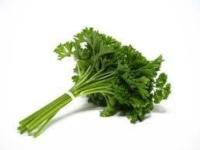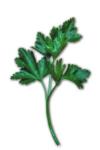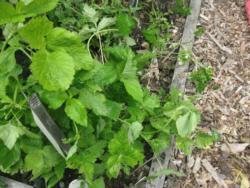Parsley Report
Parsley Trial at Elkus Research Garden 2011
Prepared by: Cynthia Morris, April 12, 2012
Introduction
The Master Gardeners at Elkus Ranch designed a trial to test a variety of American and Italian parsleys comparing vigor, taste, and disease resistance in zone 17. Elkus Ranch is located near the coast approximately 6 miles south of Half Moon Bay. Over twelve different varieties of flat and curly parsley were planted including three types of Italian seed and seven varieties of American seed. I also planted a Japanese variety called ‘Mitsuba’ and a root parsley called ‘Arat’, to see how they compared to more familiar parsleys.
Purpose
The objective of the study was to observe the differences in growth and taste between Italian, American, Arat (parsnip rooted), and Japanese parsleys.
Background
History
Our word parsley is a corruption of two Latin words, ‘petros’ and ‘selinon’ meaning ‘rock’ and ‘celery’, respectively. Dioscorides, a Greek physician of the early Roman Empire, is said to have given the plant its name, ‘Petioselunum crispum’.
Parsley originally grew wild near the Mediterranean. The Greeks used it before recorded history. The ancient Greeks and Romans did not eat parsley. However, they did grow it in their gardens as a border plant, and thought it to be wonderful fodder for the chariot horses. Parsley was appreciated for its medicinal properties long before it became accepted as a food or spice. Because parsley was confused with false parsley (which is poisonous), the flat variety was not quick to catch on. However the curly leafed variety soon found its way to the plate and dishes. Parsley has the ability to clean your breath and palate.
Thankfully, someone figured out that parsley was quite tasty and worthy of growing.
Description
There are three common varieties of this popular, bright green biennial: flat leaf (Italian), curly leaf, and parsnip rooted (Arat).
Garden parsley is a bright green hairless biennial herbaceous plant in temperate climates, and an annual herb in sub-tropical areas. Where it grows as a biennial, during the first year, it forms a rosette of tri-pinnate leaves 10-25cm long with numerous 1-3cm leaflets, and a taproot used as a food store over the winter. In the second year it grows a flowering stem to 75cm tall with sparser leaves and flat-topped 3-10cm diameter umbels with numerous 2mm diameter yellow to yellowish-green flowers. The seeds are ovoid, 2-3mm long, with prominent style remnants at the apex. One of the compounds of the essential oil is apiol. The plant normally dies after seed maturation.
The curly type, Petroselinum crispum, is aptly named for the clean, fresh, crispy taste of the tightly bunched, bright green leaves. This crispiness is one of parsley's best attributes, adding texture and color when added just before serving. This is the parsley that is the essential ingredient in the classic flavoring: bouquet garni, along with thyme and bay leaves. Together with tarragon, chives and chervil, parsley helps make up the traditional French flavoring blend of fine herbs. The root can be chopped and added at the last moment, it perks up sauces and salads.

There is a third and much less familiar form of parsley called Arat parsley or soup parsley, Petroselinum crispum tuberosum. In this variety the root is the star of the show. The leaves can be used but they are a bit too strong for most people's taste. Its flavor is a pungent cross between celery and parsley -- definitely tasty. It can be sliced raw and added to salads, or cooked and added to soups, stews, gratins, or vegetable purees.
A fourth type of parsley called Mitsuba was also studied. This beautiful plant, commonly known as Japanese parsley, is easy to cultivate. It is often found growing wild in parts of Asia, notably Japan. Known by its tri-leaved foliage, this perennial has a stronger flavor than the American parsleys and reminds one of celery.
Parsley attracts some wildlife. Some swallowtail butterflies use parsley as a host plant for their larvae. The caterpillars are black and green striped with yellow dots, and will feed on parsley for two weeks before turning into butterflies. Bees and other nectar-feeding insects visit the flowers. Birds such as the goldfinch feed on the seeds.
Parsley is rich in iron, vitamins A, B and C and oil called apiol, which is extracted from the seeds and used to treat infections of the urinary tract, general disease prevention, digestion and circulation problems, and kidney stones.
Cooking with parsley
Once you find out what parsley can do for dishes, you'll wonder why you ever treated it like a garnish. You can add fresh parsley to soup stocks, sprinkle it on potatoes, mix it into rice pilafs, bake it with roasted meats or fish, add it to stews, even blend it with scallions, tomatoes, mint and bulgur wheat to make a mouth watering tabbouleh.
Methodology
Pretroselinum crispum (American curly), Pretroselinum neapolitanum (Italian Flatleaf), Petroselinum crispum tuberosum (Arat or Parsnip Root) and Cryptotaenia japonica (Japanese Mitsuba) were grown for this study in the following manner.
Seeds of 12 different types of parsley including American, Italian Arat and Mitsuba were planted on February 26 at my home in a sunny window in containers filled with organic soil. Before planting, all seeds were soaked in warm water for 24 hours. It was winter and the sun was not always out. I did not use a heating pad. Parsley is notorious for long germination. My first seed germinated on March 17, the rest appeared in the next week and half. The first seed up was an American curly leaf. The Mitsuba had the highest germination rate. The seedlings were ‘up planted’ (put into larger pots) between April 10 and April 25 after the seeds developed their first true leaves. Most of the parsley was planted at Elkus Ranch on May 31 in a raised bed containing ½ soil and ½ compost. The remaining seedlings were planted later in June when they were ready. The parsley bed was shared with an assortment of edible flowers including chrysanthemum, calendula and salvia.

Results
The weather was cool and foggy for 2 months. I lost a curly leaf a few weeks after planting. The parsley grew slowly. The flat leaf parsley grew larger and faster than the curly leaf. The Mitsuba grew very well. It has very round leaves and can capture a lot more energy than the small leaves. The Arat growth was similar to the flat leaf parsley. The edible flowers were growing very well, maybe too well. They were shading the parsleys. Once the edible flowers were staked up and pulled away from the parsley, the plants received more sun resulting in better growth. The first measurements on June 7th were taken before the flowers were staked and tied back.
Height in Inches
Parsley Type June 7 August 23 Italian or
Measurement Measurement American Seed
Prezzemolo Gigante/flat 8” 30” Italian
Prezzemolo commune/flat 7” 28” Italian
Arat/ flat 4” 12” American
Forest Green/flat 5” 14” American
Italian Flat Heirloom/flat 5” 12” American
Mitsuba/ flat 3” 24” American
Parsley plain or simple/flat 3” 20” American
Italian Dark Green/ flat, died*
Riccio Verde/curly 5” 14” Italian
Moss Curl/ curly 3” 17” American
Green River/curly 4” 14” American
Triple curl/ curly 3” 13” American
* the parsley died before it could be measured.
The measurements show the flat leaf parsley to be double the size of the curly, which was expected. The average height on 6/7 of the flat was 5.75”, the curly 4.60”. The August 23 measurements for flat leaf were 23”, the curly 14”. When the weather became warmer and the flowers allowed more sun, the flat leaf really started to grow.
A comparison of vigor shows the following: the two Italian flat parsleys grew 8” taller then the tallest American variety; the curly American parsley seed grew as well or better then the Italian curly. The real difference came with the Italian flat parsley. The Japanese Misuba parsley grew very well as it has a flat leaf.
I picked parsley, placed it in bags and sent it home with co-workers asking them to taste and assess which parsleys they liked best and why, and how they used them. The bags were marked with numbers not names. The next week the returns were in. The Giant Italian parsley won by far the taste tests for the flat leaf. An American seed called Green River won for curly varieties. No one liked the Misbuba or the Arat parsley, as they were very bitter. I have to say it was a very pretty plant in the landscape. I would grow it for that reason.
Conclusion
I really enjoyed growing parsley from start to finish. The team was great. We had a great time and worked well as a team. I did make some observations about parsley that I would like to share.
Parsley is difficult to germinate and was very slow to start. In the future, I will start my seeds a little later when it is not so cold. A heating pad can be used to speed the process of germination. I might try using row cover to help keep the parsley a little warmer. I also think it would have prevented the rabbits from eating the parsley. It became evident that the flat leaf parsley was going to do a lot better than the curly leaf parsley. The flat leaf parsley was able to gather more energy with its flat surface. The curly leaf could not gain as much energy, so it grew slower. If I lived in zone 17 I might only grow flat leaf parsley.
The Italian flat leaf parsley really grew well and tasted great. I would definitely grow it in zone 17. The Green River curly did not grow as fast as the flat leaf. If you loved curly parsley than I would grow the Green River for taste not size.
The Arat parsley can be dug up and the root used like a turnip. When I dug it up, something had eaten it, probably a gopher. Gopher wire would be in order next time I plant Arat parsley.
If I were to run the test again I would not put the edible flowers in the same bed that I was testing the parsley. The idea was to make a pretty bed with parsley as the border and the flowers in the center. The flowers grew quit large and shaded the parsley. At home parsley in the border works really well but for testing it did not work.
I enjoyed running the parsley test at Elkus. It was enjoyable working with other Master Gardeners and helping with all the different projects. I learned a great deal about parsley that I often share with friends.
For more information, please contact the Master Gardener Help Line at (650) 726-9059 ext. 107
Prepared by: Cynthia Morris, Master Gardener, San Mateo/San Francisco Counties
References
Wikipedia the Free Encyclopedia. Parsley: http://en.wikipedia.org/wiki/Parsley
The George Mateljan Foundation, The World’s Most Healthy Foods: http://www.whfoods.com/genpage.php?tname=foodspice&dbid=100
The History of Parsley: http://www.ourherbgarden.com/herb-history/parsley.html
Parsley Images: Retrieved from Google
For a PDF version of this report, click here.
